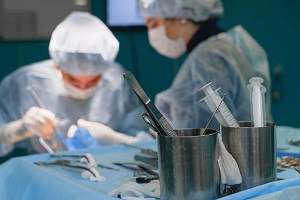Why is Laparoscopy Not Recommended for Hydrosalpinx?
Hydrosalpinx can have various impacts on fertility. The accumulation of fluid can interfere with the pickup and transport of eggs, affecting the fertilization process. Additionally, harmful substances in the fluid may have toxic effects on embryos, reducing the success rate of embryo implantation. Moreover, hydrosalpinx may increase the risk of ectopic pregnancy.

Laparoscopic treatment for hydrosalpinx is a standard method, but its efficacy and applicability are subject to debate. In some cases, it is not recommended as the primary treatment option.
Laparoscopic surgery involves inserting a laparoscope and other instruments into the abdomen, using a camera to display the abdominal cavity on a screen, allowing surgeons to perform operations by observing the screen. This procedure offers advantages such as minimal trauma and faster recovery.
During laparoscopic treatment for hydrosalpinx, surgeons typically make small incisions in the patient's abdomen and insert the laparoscope and surgical instruments. By observing through the laparoscope, surgeons can locate the hydrosalpinx and proceed with appropriate interventions. Standard procedures include salpingostomy or salpingectomy.
Why is Laparoscopy Not Recommended for Hydrosalpinx?
1. Surgical Risks and Complications
Every surgery carries risks of infection, and laparoscopic surgery is no exception. Poor sterile technique during surgery or inadequate postoperative care can lead to infections.
During the surgery, there is a risk of damaging blood vessels, potentially causing bleeding. Severe bleeding may require blood transfusion or additional surgery for hemostasis.
Despite the advantages of minimal trauma, laparoscopic surgery can still inadvertently damage surrounding tissues and organs such as the intestines or bladder.
2. Limitations of Therapeutic Effectiveness
Even after treating hydrosalpinx via laparoscopic surgery, there is a specific recurrence rate. This may occur if the surgery fails to eradicate the underlying cause or if the fallopian tubes re-adhere postoperatively.
Furthermore, while laparoscopic surgery can alleviate symptoms of hydrosalpinx, its effectiveness in improving fertility remains uncertain. Some patients may still experience difficulty conceiving naturally post-surgery, necessitating further treatment options.
3. Other Considerations
Despite being less invasive, laparoscopic surgery requires patients to have specific physical conditions and tolerance. Patients with poor health conditions or concurrent illnesses may not be suitable candidates for laparoscopic surgery.
Additionally, the costs associated with laparoscopic surgery are relatively high, which may pose a financial burden to patients.
What other treatment methods are there?
1. Conservative Treatment
For patients with mild hydrosalpinx and no significant symptoms such as pain or infertility, doctors may recommend conservative treatment initially. This involves using antibiotics to treat potential infections and employing Chinese herbal medicine like Fuyan Pill to regulate and reduce inflammation through non-surgical means.
The advantage of conservative treatment lies in avoiding surgical risks and minimizing trauma to the reproductive system.
2. Tubal Occlusion Procedures
Tubal occlusion procedures involve introducing embolic materials into the fallopian tubes to block their lumens, preventing the backflow of fluid into the uterine cavity. This procedure is relatively simple and minimally invasive.
The advantages include minimal trauma, quick recovery, and minimal impact on ovarian function. However, disadvantages include potential impairment of tubal function and difficulty achieving tubal patency post-occlusion.
3. In Vitro Fertilization (IVF) Technology
IVF is suitable for patients with severe hydrosalpinx and difficulty conceiving naturally. The success rate of IVF depends on factors such as the patient's age and the quality of eggs and sperm.
For patients with hydrosalpinx, addressing the fluid accumulation before IVF is often necessary to improve success rates.
In conclusion, treating hydrosalpinx is complex and requires consideration of multiple factors. When selecting a treatment method, it's essential to assess the patient's specific circumstances and weigh the pros and cons of each treatment option. Patients should actively cooperate with their doctors, maintain a positive mindset during treatment, and participate in decisions to enhance treatment outcomes.
Recommend readings:
Hydrosalpinx Must Be Treated! It Seriously Affects IVF Success Rates
Can Chlamydia Infection Cause Hydrosalpinx?
Blocked Fallopian Tubes: Is Laparoscopic Surgery for Clearance Necessary?
Is a Fallopian Tube Examination Painful?
previous pageWhat are the Effects of Salpingectomy on Women?
next page- Herbal Treatment for Adenomyosis with Large Uterine Enlargement and Heavy Bleeding
- Effective Chinese Herbal Remedies for Adenomyosis Pain: End Your Period Discomfort
- Endometriosis and Debilitating Bowel & Bladder Pain: Diagnosis, Treatments, and Hope for Relief
- Severe Endometriosis Treatment: Chronic Pelvic Pain Relief and Infertility Solutions
- Revealed: Why Does Postcoital Bleeding Occur After a Mycoplasma Infection in Women, and How to Deal With It?
Testimonials
- Adenomyosis with Ureaplasma Urealyticum Cured by Fuyan Pill
- Tubal blockage with hydrosalpinx can be cured by TCM shortly
- Fuyan Pill Helps A woman with Adenomyosis Get Pregnant
- A Woman with Hydrosalpinx Is Cured with Fuyan pill
- Pelvic Inflammatory Disease Testimonials
- Irregular Vaginal Bleeding and Endometrial Thickening Cured by Fuyan Pill
- Pruritus Vulvae and Frequent Urination: Mycoplasma Infection Cured after 2 Courses



